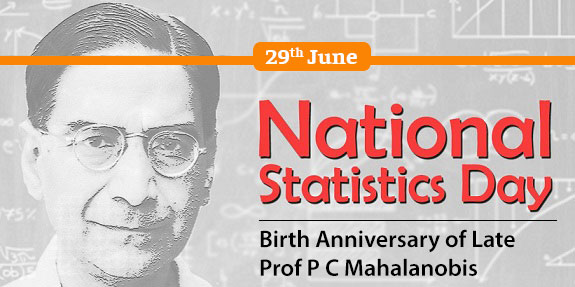National Statistics Day - 29 June
National Statistics Day is observed every year on 29th June in recognition of the invaluable contribution of well-known scientist and statistician Shri Prasanta Chandra Mahalanobis. My homage to the father of modern statistics in India on his 127th birth anniversary. A key member of the first Planning Commission of Independent India & Padma Vibhushan awardee, P C Mahalanobis is considered to be the father of modern statistics in India. The objective of this day is to create public awareness among people about the importance of statistics in daily life and in the process of planning and development.
This day is included in the category of Special Days to be observed at the national level every year. Each year a different theme is decided to mark the day. This theme is mostly about an issue that is of national importance.
2020 is the 14th edition of National Statistics Day.
Theme 2020: SDG- 3 (Ensure healthy lives and promote well-being for all at all ages) & SDG- 5 (Achieve gender equality and empower all women and girls)
About National Statistics Day
The National Statistics Day observed on June 29 was officially designated by Union Government in 2007 in recognition of notable contributions made by Late Professor PC Mahalanobis in the fields of statistics. Since then it is observed annually and every year Union Ministry of Statistics & Programme Implementation (MoSPI) and Indian Statistical Institute (ISI) selects a particular theme for the day. National Statistics Day is celebrated annually on the occasion of Birth anniversary of India’s eminent statistician, Late Prof Prasanta Chandra Mahalanobis, in recognition of his invaluable contribution to establishing the National Statistical System. The day also commemorates contributions made by Mahalanobis in the fields of statistics and economic planning.

To mark the occasion a series of events have been planned across India. Winner of Prof. C R Rao Award 2019 for notable contribution in the field of Statistics was felicitated during the program on the occasion of the day held in New Delhi. Also, winners of All India level ‘On the Spot Essay Writing Competition’ for Post Graduate Students on subjects relevant to Statistics organized at were also felicitated.
About PC Mahalanobis
He was an Indian scientist and applied statistician who lived from 29 June 1893 to 28 June 1972. He became the first Indian statistician to receive world recognition and is called as Father of Indian Statistics. He is also referred to as the chief architect of the Indian statistical system.
In 1931, he established the Indian Statistical Institute (ISI) in Kolkata and contributed to the design of large-scale sample surveys. In 1933 institute founded journal Sankhya, 1st Indian statistical journal, along the lines of Karl Pearson’s Biometrika. In 1959 ISI was made an autonomous body of Ministry of Statistics & Programme Implementation (MoS&PI). After 1947 (Post-independence), he served as the honorary statistical adviser to the cabinet and helped in the establishment of Central Statistical Organisation (CSO), the National Sample Survey (NSS), and the Annual Survey of Industries (ASI).
He had made pioneering studies in anthropometry India but in 1936 he introduced a statistical measure called Mahalanobis distance, widely used in cluster analysis and classification techniques for which he is widely known. He was also a member of the first planning commission (1951-56) of free India. The II Five Year Plan (1957-62) relied on Mahalanobis’s mathematical description of the Indian economy and this plan encouraged the development of heavy industry in India and later came to be known as the Basic Industry strategy of economic Growth or Nehru-Mahalanobis Model.
He was honored with many prestigious awards by India as well as foreign countries. Those are Padma Vibhushan (1968), Weldon Memorial Prize from the University of Oxford (1944), Fellow of the Royal Society, London(1945).
Important Facts about PC Mahalanobis
- He was an Indian scientist and applied statistician. He was born on 29 June 1893 in Kolkata, West Bengal, and died on 28 June 1972 in Kolkata.
- He was the first statistician from India to receive world recognition.
- He is referred to as the chief architect of the Indian statistical system as well as the father of statistical science in India.
- He established Indian Statistical Institute (ISI) in 1931 in Kolkata. The institute founded India’s first statistical journal Sankhya, along lines of Karl Pearson’s Biometrika. ISI was made an autonomous body of MoSPI in 1959.
- Post-independence, he had helped (as an honorary statistical adviser to the cabinet) in the establishment of Central Statistical Organisation (CSO), National Sample Survey (NSS), and Annual Survey of Industries (ASI).
- In 1947, he was elected Chairman of United Nations Sub-Commission on Statistical Sampling and held this post until 1951.
- He had introduced a statistical measure named Mahalanobis distance in 1936. It is widely used in cluster analysis and classification techniques. His most important contribution is related to Large-Scale Sample Surveys.
- He introduced three key concepts to the theory and practice of sample surveys viz. Pilot surveys, Optimum survey design, and Inter Penetrating Network of sub-samples technique (IPNS).
- He was also a member of the Planning Commission (PC) from 1955 to 1967. The 2nd Five-Year Plan had relied on the mathematical description of the Indian economy framed by Mahalanobis. This plan had encouraged the development of heavy industry in India and later became known as the Nehru-Mahalanobis model or Basic Industry strategy of economic growth.
- He also made pioneering studies in anthropometry in India.